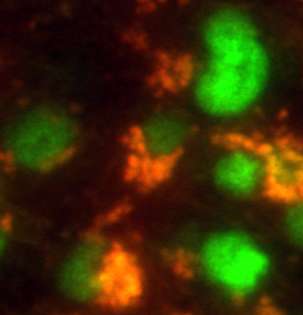Stem cells lurking in tumors can resist treatment

Scientists are eager to make use of stem cells' extraordinary power to transform into nearly any kind of cell, but that ability also is cause for concern in cancer treatment. Malignant tumors contain stem cells, prompting worries among medical experts that the cells' transformative powers help cancers escape treatment.
New research proves that the threat posed by cancer stem cells is more prevalent than previously thought. Until now, stem cells had been identified only in aggressive, fast-growing tumors. But a mouse study at Washington University School of Medicine in St. Louis shows that slow-growing tumors also have treatment-resistant stem cells.
The low-grade brain cancer stem cells identified by the scientists also were less sensitive to anticancer drugs. By comparing healthy stem cells with stem cells from these brain tumors, the researchers discovered the reasons behind treatment resistance, pointing to new therapeutic strategies.
"At the very least, we're going to have to use different drugs and different, likely higher dosages to make sure we kill these tumor stem cells," said senior author David H. Gutmann, MD, PhD, the Donald O. Schnuck Family Professor of Neurology.
The research appears online March 12 in Cell Reports.
First author Yi-Hsien Chen, PhD, a senior postdoctoral research associate in Gutmann's laboratory, used a mouse model of neurofibromatosis type 1 (NF1) low-grade brain tumors to identify cancer stem cells and demonstrate that they could form tumors when transplanted into normal, cancer-free mice.
NF1 is a genetic disorder that affects about 1 in every 2,500 babies. The condition can cause an array of problems, including brain tumors, impaired vision, learning disabilities, behavioral problems, heart defects and bone deformities.
The most common brain tumor in children with NF1 is the optic glioma. Treatment for NF1-related optic gliomas often includes drugs that inhibit a cell growth pathway originally identified by Gutmann. In laboratory tests conducted as part of the new research, it took 10 times the dosage of these drugs to kill the low-grade cancer stem cells.
Compared with healthy stem cells from the brain, the cancer stem cells made more copies of a protein called Abcg1 that helps those cells survive stress.
"This protein blocks a signal from inside the cells that should make them more vulnerable to treatment," Gutmann explained. "If we can identify a drug that disables this protein, it would make some cancer stem cells easier to kill."
Although the mice the researchers studied were bred to model NF1 optic gliomas, the researchers said the findings could be applied more broadly to other brain tumors.
"Because stem cells haven't differentiated into specialized cells, they can easily activate genes to turn on new developmental programs that allow the cells to survive cancer treatments," said Gutmann, who directs the Washington University Neurofibromatosis Center. "Based on these new findings, we will have to develop additional strategies to keep these tumors from evading our best treatments."
More information: Chen Y-H, McGowan LDA, Cimino PJ, Dahiya S, Leonard JR, Lee DY, Gutmann DH. Mouse low-grade gliomas contain cancer stem cells with unique molecular and functional properties. Cell Reports, online March 12, 2015.

















